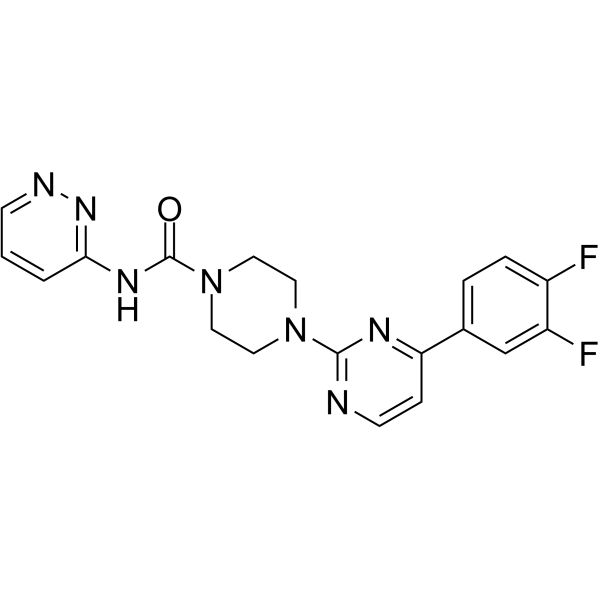TAK 21d
Modify Date: 2025-08-27 11:04:28

TAK 21d structure
|
Common Name | TAK 21d | ||
|---|---|---|---|---|
| CAS Number | 1143578-94-2 | Molecular Weight | 397.381 | |
| Density | 1.4±0.1 g/cm3 | Boiling Point | N/A | |
| Molecular Formula | C19H17F2N7O | Melting Point | N/A | |
| MSDS | N/A | Flash Point | N/A | |
Use of TAK 21dFAAH-IN-6 (compound 21d) is a potent, orally active and cross the blood-brain barrier fatty acid amide hydrolase (FAAH) inhibitor with IC50s of 0.72, 0.28 nM for hFAAH, rFAAH, respectively. FAAH-IN-6 shows dose-dependent analgesic efficacy in animal models of both neuropathic and inflammatory pain[1]. |
| Name | 4-[4-(3,4-Difluorophenyl)-2-pyrimidinyl]-N-(3-pyridazinyl)-1-piperazinecarboxamide |
|---|---|
| Synonym | More Synonyms |
| Description | FAAH-IN-6 (compound 21d) is a potent, orally active and cross the blood-brain barrier fatty acid amide hydrolase (FAAH) inhibitor with IC50s of 0.72, 0.28 nM for hFAAH, rFAAH, respectively. FAAH-IN-6 shows dose-dependent analgesic efficacy in animal models of both neuropathic and inflammatory pain[1]. |
|---|---|
| Related Catalog | |
| Target |
IC50: 0.72 nM (hFAAH); 0.28 nM (rFAAH)[1] |
| In Vivo | FAAH-IN-6 (compound 21d) (1-10 mg/kg; p.o.) shows significantly ameliorates tactile allodynia in a dose-dependent fashion in SNI-induced neuropathic pain rats model[1]. FAAH-IN-6 (3-10 mg/kg; p.o.) shows significantly ameliorates tactile allodynia of the ipsilateral hind paw in CFA-induced inflammatory pain model[1]. |
| References |
| Density | 1.4±0.1 g/cm3 |
|---|---|
| Molecular Formula | C19H17F2N7O |
| Molecular Weight | 397.381 |
| Exact Mass | 397.146271 |
| LogP | 1.43 |
| Index of Refraction | 1.645 |
| InChIKey | JCWVFSJNIBAGQN-UHFFFAOYSA-N |
| SMILES | O=C(Nc1cccnn1)N1CCN(c2nccc(-c3ccc(F)c(F)c3)n2)CC1 |
| 1-Piperazinecarboxamide, 4-[4-(3,4-difluorophenyl)-2-pyrimidinyl]-N-3-pyridazinyl- |
| 4-[4-(3,4-Difluorophenyl)-2-pyrimidinyl]-N-(3-pyridazinyl)-1-piperazinecarboxamide |